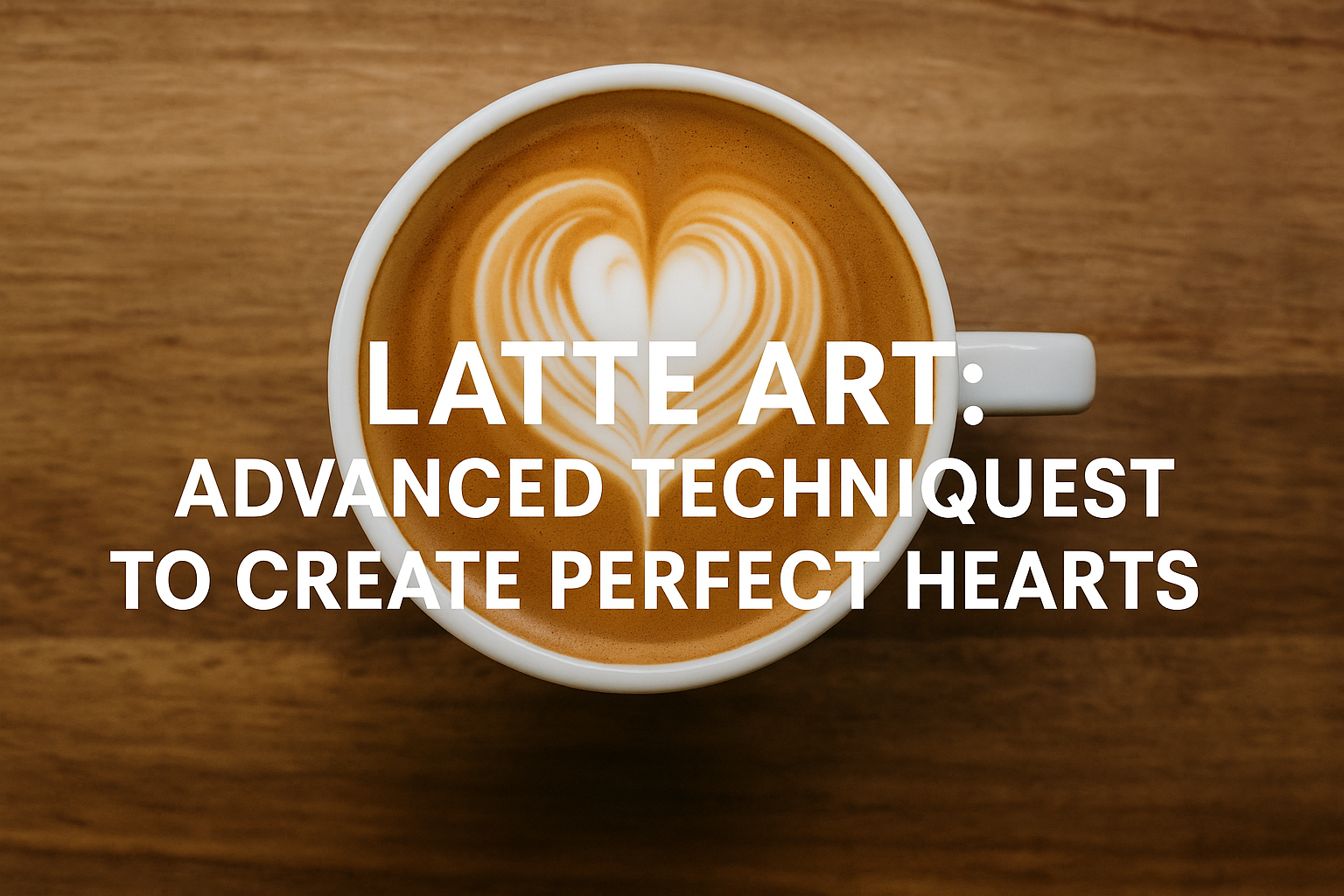The heart is often the first design every barista learns in latte art. It’s simple, elegant, and timeless.
But while it may seem basic on the surface, creating a truly perfect heart requires refined skills and a deep understanding of milk texture, pouring rhythm, and hand control.
If you’ve already mastered the basics and want to bring your hearts to the next level, this article will guide you through advanced techniques to improve symmetry, contrast, shape, and overall presentation.
Let’s elevate your latte art from good to exceptional.
Perfecting the Foundation
Before diving into advanced methods, make sure your espresso and milk are consistently solid.
Your espresso should have a thick, even crema. Your milk should be textured into smooth microfoam with a glossy sheen. These two elements are your foundation.
Without consistency here, even the best techniques will fall flat.
Dialing in the Ideal Milk Texture
For perfect hearts, your milk should be:
- Smooth and velvety
- Slightly thicker than what you’d use for rosettas
- Free of large bubbles
A thicker foam allows you to control the roundness and fullness of the heart, especially in the edges. Use whole milk for best results and steam to around 60–65°C (140–150°F).
If the milk is too thin, the heart will look washed out. If it’s too thick, it will sit on top and distort the shape.
Advanced Pitcher Control
Your pitcher is your brush. For advanced hearts, every angle and motion matters.
Here are some control techniques to practice:
1. Pitcher Tilt and Grip
Hold the pitcher with your thumb on top of the handle and your index finger along the side. This grip offers maximum control and fluidity.
Tilt the cup toward you at a 20 to 30-degree angle, and match the angle with your pitcher for smooth milk flow.
2. Entry Point Precision
Start your pour from 6–10 cm above the surface of the espresso. This breaks the crema slightly and lays a solid foundation.
As you begin to see milk appear on the surface, lower the pitcher close to the crema — almost touching — and increase the flow rate to build the heart.
Precision is key. Pouring even slightly off-center can make the heart look asymmetrical.
3. Controlled Flow Rate
Use a gentle, steady flow as the base begins, and gradually increase as you pour closer.
Once the milk hits the top layer, maintain a moderate flow to allow the foam to rise and form a round base.
Practice changing flow rate smoothly — many beginners go from fast to slow too abruptly, which causes the shape to split.
Layering for Shape and Depth
In advanced heart pours, the design is not just a flat stamp — it has depth, contour, and motion.
The Drop-and-Push Technique
As your foam appears on the surface, let it drop gently into the center. Then slightly push forward while keeping the flow steady.
This movement builds a layered effect, giving the heart a full and plump appearance. It also prevents the tail from piercing too far through the shape.
The Controlled Cut-Through
To finish the heart, reduce your flow and pull the stream straight back through the center.
This “cut” creates the point at the bottom. For a cleaner finish, time the cut perfectly as the foam begins to thicken — too early and the heart splits; too late and it bulges.
Experiment with pulling the cut-through at different speeds and angles to control the length of the tail.
Using Wrist and Finger Pressure
Advanced baristas know how to manipulate their pitcher with tiny changes in wrist angle and finger pressure.
Practice the following movements:
- Slight wrist flicks to adjust width
- Finger tension to stabilize tremors
- Elbow control to manage pour speed
Even small motions make a big difference when you’re working with such fine detail.
Film yourself pouring and replay in slow motion. Look for inconsistencies in angle or speed and adjust accordingly.
Controlling Contrast and Color
A perfect heart should have bold white foam that contrasts clearly with the rich brown crema. This requires both timing and milk management.
Tips for Maximizing Contrast
- Don’t pour too early — wait until crema is evenly settled
- Avoid pouring too slowly at the start, or the design will blend in
- Use freshly pulled espresso for thick, golden crema
- Keep your milk swirling before pouring to maintain texture
The more precise you are with timing, the more vibrant and defined your heart will appear.
Variations of the Classic Heart
Once you’ve mastered the standard shape, try experimenting with advanced variations. These showcase your control and creativity.
1. Double Heart
After creating the first heart, reset your pour height and repeat the drop again before the cut-through. This creates a layered heart effect.
It requires quick motion and consistent flow — otherwise the second shape won’t appear cleanly.
2. Offset Heart
Pour the heart slightly to the side of the cup’s center. This creates a modern, artistic effect often used in latte competitions.
Offset hearts are harder to balance, but visually striking when done right.
3. Stretched Heart
Pull the cut-through slower and with a wider curve, creating a heart with a longer tail and elegant flow. Great for larger cups or 12 oz lattes.
This variation needs a bit more milk and a slightly thinner foam for fluid movement.
Common Mistakes to Avoid
Even advanced baristas make small errors that affect heart quality. Here’s what to watch for:
- Pouring too high during the heart stage: creates splatter and breaks shape
- Hesitating on the cut-through: results in wobbly or crooked tails
- Overtextured milk: leads to stiff foam that doesn’t settle well
- Undertextured milk: causes designs to fade quickly
- Inconsistent pitcher angle: makes one side of the heart flatter than the other
Practice with purpose. Focus on one variable at a time when troubleshooting.
Training Exercises for Advanced Heart Art
Improvement comes through focused repetition. Here are a few exercises to sharpen your skills:
Mirror Drills
Stand in front of a mirror and pour into a dry cup. Watch your hand movements and angles to ensure consistency.
Water Practice
Use a pitcher of water and a cup with food-colored water to simulate milk/espresso. Practice flow control and cut-through without wasting ingredients.
Pour-Stop-Pour
During your pour, stop halfway, pause, and continue. This teaches control over pressure and helps you reset your balance.
Try doing 10 hearts in a row, aiming for perfect symmetry each time.
Heart Pours for Competition-Level Precision
If you’re aiming to compete or create content-worthy pours, pay attention to:
- Symmetry: Both sides should mirror each other.
- Contrast: Strong white vs. dark brown is essential.
- Edge Definition: Clean borders without frayed lines.
- Centering: The heart should sit evenly in the cup.
Use a stopwatch to measure your pour time. Consistency is more important than speed.
Pouring in Different Cups
Not all cups are created equal. For perfect hearts, use:
- Rounded bottom
- Thin or medium rim
- 6–8 oz capacity
Avoid tall or narrow cups until your control is very refined.
Experiment with the same heart pour in different cups to learn how shape affects milk flow and foam distribution.
When to Pour for Best Results
Timing is everything. Pour your milk within 10–20 seconds of steaming. Wait too long and the foam separates. Pour too early and the crema hasn’t stabilized.
Also, let your espresso settle for 5–10 seconds before pouring. This gives the crema time to form evenly, setting the stage for clean lines.
Final Thoughts: Mastery Comes with Intention
A perfect heart is more than a symbol — it’s a statement of your skill. While it may look simple, it reflects precision, awareness, and confidence in your craft.
Don’t settle for “good enough.” Repetition without purpose won’t get you there. Train with intention, focus on each variable, and challenge yourself to improve by 1% each pour.
Soon, your hearts won’t just look good — they’ll be competition-ready, consistent, and beautifully expressive.

Marcelo Rodrigues is a passionate barista with over 7 years of experience in specialty coffee. He’s worked in top cafés, led barista training sessions, and now shares practical tips to help beginners and coffee lovers improve their skills. Through this blog, Marcel makes the world of coffee more accessible—one cup at a time.

